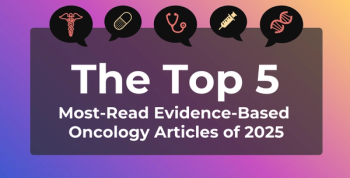
2-Year Followup Data From the GRIFFIN Trial in Transplant-Ineligible NDMM
Updated results from the GRIFFIN trial in newly diagnosed multiple myeloma, including consideration for frontline 4-drug regimens and depth of response.
Episodes in this series

Transcript:
Rafael Fonseca, MD: At ASH [American Society of Hematology Annual Meeting], an update was made on the GRIFFIN study. The GRIFFIN studies are a randomized phase 2 trial that addresses the worth of adding daratumumab to a triplet as frontline therapy for multiple myeloma. The 2 arms of this trial are daratumumab–VRd [bortezomib, lenalidomide, dexamethasone] vs VRd [bortezomib, lenalidomide, dexamethasone]. Patients subsequently get a transplant, then get 2 more cycles of daratumumab–VRd [bortezomib, lenalidomide, dexamethasone].
Then they go onto maintenance. This maintenance cycles 7 through 32. If you get daratumumab–VRd [bortezomib, lenalidomide, dexamethasone], then you get daratumumab–R [lenalidomide]. If you get VRd [bortezomib, lenalidomide, dexamethasone] only, then you get R [lenalidomide]–maintenance. The primary end point for this clinical trial was stringent complete response [CR]. The secondary end point, of course, is progression-free survival [PFS].
We’ve seen the data for the study, so this update refined our understanding of what we’re seeing. First, the rate of response is superior with the 4 drugs, at the end of consolidation, after 1 year of maintenance and after 2 years of maintenance, which was the subject of this update. The study reported a complete response rate of 82% after 2 years of maintenance, with the 4 drugs vs 61%. There’s a 20-percentage-points difference between the 2 arms in favor of daratumumab, which continues to build on the story that it’s important to have this very deep response.
The next point, which is very important, is what happened with MRD [minimal residual response] negativity. In this study, MRD was 10-5. This is going to be looked at with many filters, whether you look at MRD in those patients who have CR or better only, or whether you look at only those who are evaluable. But if you look at this from the perspective of the intention to treat, MRD negativity was reached in 64% of patients. Again, it was 10-5. We’ve got the quad vs 30% only in patients who have the 3-drug combination. Those results are pretty far apart from one another. I’d argue beyond further controversy that 4 drugs result in a much better result of MRD negativity.
People will want to see the effects of this on the sustainability of those responses, and we’re very fortunate that we start to see some reports of progression-free survival. This is a phase 2 study, but the curves appear to be separating, almost as if it’s behaving like a phase 3 study. At 3 years they reported a PFS of close to 88.9% vs 81.2% for the triplet. When you go out to 4 years, then you see a significant difference. Even though it’s not reported, it appears to be almost a 20-percentage-point difference in progression-free survival. I’m very keen on seeing what happens over time with this clinical trial.
There’s a larger trial underway that I don’t think has been reported. It’s exactly the same as GRIFFIN, but it’s a randomized phase 3 study. It may set the stage to put a final statement on the question of whether you need monoclonal antibodies for frontline therapy. For people who want to see all the levels of evidence to support that decision, that would be the clinical trial. But as I see this analysis and what’s reported in Master, it’s beyond question that we must use monoclonal antibodies for frontline therapies.
Based on the results presented in the GRIFFIN and MASTER trials, it’s clear that the standard of care needs to change. I realize that statement has a lot that follows: is this part of your health system? Do you have coverage for that? But if you think about this from the perspective of access apart, from a medical level, should you continue to use triplets? I’d argue that’s not the case. If we think a person is fit enough to go through the stem cell transplant, then we should think of that person as clearly being fit enough to be able to get daratumumab or isatuximab in the future if that becomes part of the reported studies. This is being explored for the frontline therapy of the disease.
In multiple myeloma, the depth and durability of the response goes hand in hand with quality of life. We see this question often from patients who might tell us more about quality than quantity. I tell them this is a false dichotomy. If we can control the myeloma cells and bring them to very low levels, then that usually results in healing of bone lesions. Sometimes we can reestablish appropriate renal function. You’ll see an improvement in the quality of life. Some aspects may be difficult to completely overcome, in particular fractures of the spine, vertebral body compression fractures, can be problematic in the long term. But it’s a false dichotomy. If you have good disease control, especially if we have durable disease control, then you’ll see improvements in quality of life.
To me, what’s telling is we’re seeing patients going through the next phase of treatments, like CAR [chimeric antigen receptor]Tcells or the bispecifics, and some of them are able to stop that treatment. We hear from them that treatments are hard, and if you’re on maintenance that’s pretty hard. As they stopped and are treatment-free, they stated that they’ve never felt better. There’s lots of progress, but our aspiration is there’s a future, hopefully a not-too-distant future where patients can be treated, treatment can be stopped, and then they can carry on with their lives.
Transcript edited for clarity.
Newsletter
Stay ahead of policy, cost, and value—subscribe to AJMC for expert insights at the intersection of clinical care and health economics.































































